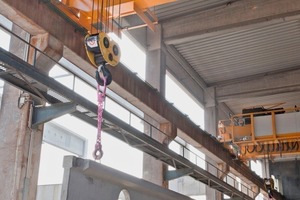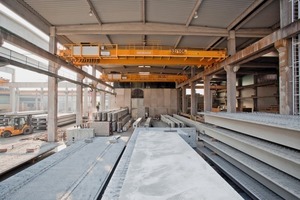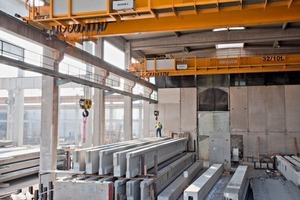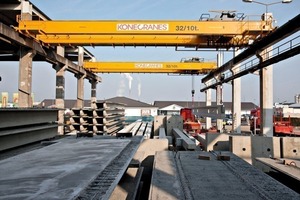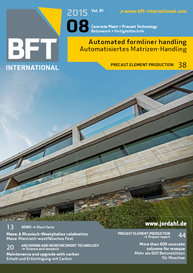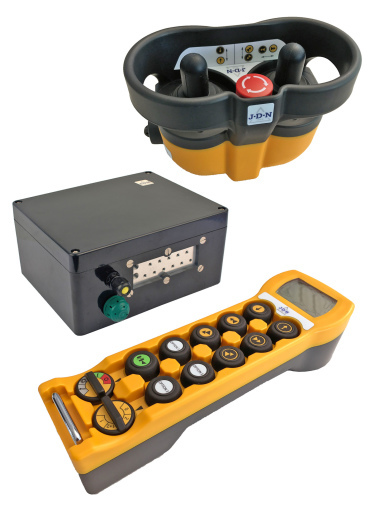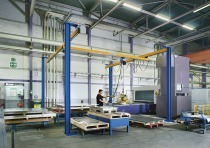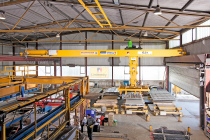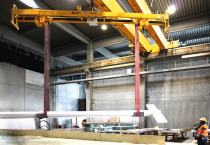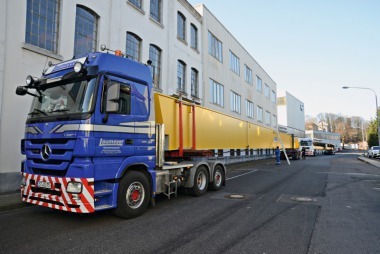Customized overhead cranes for Dreßler Bau
Be it high-rise buildings, sports arenas, entire building complexes: major projects are the day-to-day business of Dreßler Bau GmbH – this construction contractor provides a wide range of works and services in the field of building construction. For this purpose, the company produces premium precast elements and custom architectural concrete products at its precast plant in Stockstadt am Main, which has a manufacturing footprint of 90,000 m². Dreßler Bau is a long-established enterprise that has recently embarked on a growth path. It currently employs a total of 480 people at its Aschaffenburg headquarters and five subsidiaries across Germany.
Dreßler Bau had to implement new handling solutions for its production lines because of the ever-increasing number of precast elements, climbing and skateboarding facilities, and prestressed concrete bridge girders and columns manufactured by the company. For this purpose, Konecranes analyzed production processes and routes and designed a solution customized to precast element handling that relies on two high-performance overhead cranes.
Synchronous handling
To ensure a continuous, efficient manufacturing process, the new cranes are to transport the up to 40 m long precast elements with a weight of up to 64 tonnes from the factory building to the covered outdoor storage area quickly and safely. “Dreßler Bau really came up with very precise specifications regarding the working load and safety of the new cranes – not least because they will be operated in a heavy-duty environment,” says Wolfgang Jourdan, of the Konecranes industrial cranes sales team based in Dreieich. Two high-performance dual-girder overhead cranes are used to hoist and transport precast elements. Taken together, they provide sufficient capacity to handle elements that weigh up to 64 tonnes. When travelling to the interim storage facility, which is separate from the factory building, the cranes have to pass a heavy, massive protective curtain. “To prevent damage, the cranes are equipped with a custom protective frame. Both trolleys and crane infrastructure are protected by a steel structure, and the cranes’ trailing cable has been positioned between the two girders to safeguard it against impact from the curtain,” explains Jourdan.
For Dreßler Bau, Konecranes designed each of the two dual-girder overhead cranes with a 20 m span, a hoisting height of 9.70 m and a safe working load of 32 tonnes. Each of the cranes is equipped with two trolleys; they enable the safe and precise handling and transport of massive precast elements. An additional safety feature is the hook approach of the trolleys, which makes it possible to reduce the distance between the wall of the building and the lifting hook to 1.50 m whilst improving take-up, balancing and transport of the structural components.
A single operator for two cranes
During lifting and handling operations, one of the biggest challenges for the two cranes is posed by the enormous length and heavy weight of the precast elements. Konecranes has added a master/slave mode to the remote controller unit to make operation easier whilst improving safety and ensuring efficient workflows. This operating mode enables the four trolleys to hoist and move precast components in a fully synchronous sequence, and the two cranes travel in parallel to each other. “It is more efficient to handle precast elements in the master/slave mode because only a single operator is needed for both cranes, unlike in the previous setup. This speeds up the process and also makes it safer,” says Jourdan.
Dreßler Bau also cooperates with Konecranes in maintenance and servicing. Thanks to the web-based monitoring system using Truconnect Remote Services, the construction contractor can readily view all relevant data with respect to crane activity and status on a clearly structured screen. Thus, remote diagnostics support preventive maintenance, enhance crane availability, and save time. “Our handling processes are more productive because just a single employee is needed to control and operate the two cranes. Remote diagnostics make it possible for us to schedule maintenance early on, which increases crane availability and longevity and reduces costs at the same time. Konecranes have done a very good job in implementing our specifications by coming up with this future-proof crane design,” says Alexander Väth, Head of the Central Engineering and Logistics Department at Dreßler Bau.

